We’ve all heard the old adage that you should never mix business with pleasure, but Jessica Peterson, founder of The Southern Letterpress & Paper Souvenir would delightfully debate that. She’s built a business creating fine quality letterpress posters, cards, and printed goodies from her unusually narrow studio and in just three years, she’s cultivated a rich print media history to match her passion. A former fellow Central New Yorker, she’s weaved her printing prowess through three different states, creating a body of print work that caters to the art of letterpress. Here, we got a chance to catch Jessica between runs and to find out why Art Night in Northpoint, Alabama is extraordinary.
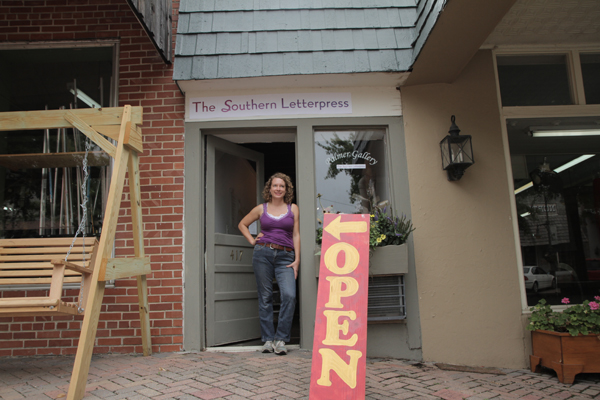
SOUTHERN CHARM I run The Southern Letterpress in Northport, Alabama. It is the narrowest print shop in the country: 6 feet wide and a city block long. In it, there are 52 cases of type, a basic bookbindery, a photo polymer plate maker and a Vandercook SP-15 printing press. I’m a book artist and letterpress printer, originally from Rochester, New York. I’ve been making artists’ books and multiples since 1994, and letterpress printing since 2006. My collaborator Bridget Elmer and I are building The Southern Letterpress to provide letterpress artwork, products and printing to undeserved areas in the Southeast. I work in Northport, Alabama, and Bridget is setting up shop in St. Petersburg, Florida.
LETTERPRESS PASSION I took a weekend class at The Center for Book Arts in New York because I wanted to print a book with beautiful text. I had been making digitally printed artists’ books and multiples, but when I saw the level of craft involved in letterpress, and how great the type looked (especially compared to a digital print), I was hooked. I soon left my day job in commercial print production in New York City to move to Alabama where I studied letterpress as part of my MFA in Book Arts at the University of Alabama. Since then, letterpress printing has slowly dominated my life and has become the impetus for many major life decisions. Printing is what keeps me grounded, especially now that I own like 3000 pounds of letterpress stuff.
INKING UP IN THE HEART OF DIXIE My print shop in located in historic downtown Northport, Alabama. The space used to be an alley between buildings which someone put a roof over and made into a long, narrow building. Before I moved in, the space was used as an art gallery, a lunch counter and a newspaper office. I’m across the street from The City Cafe, which has one of the best meat and three lunches. The Southern is next to a locally owned and very well stocked hardware store, Anders. Kentuck, an amazing art museum, is one block away.
I am part of Northport’s monthly Art Night. I typeset a simple, one color, text-based broadside, and invite everyone in the community to come try out the Vandercook and print one copy for free. The idea is that if you visit the shop every Art Night, you slowly accumulate a portfolio of prints for free. I started the print shop in Columbus, Mississippi, one floor above a still-printing newspaper press. The name of The Southern came from the first newspaper printed in Columbus, in the 1850’s.
PRINTING MENTORS Glenn House Sr., Joan Lyons, Amos Paul Kennedy Jr., Sarah Bryant, Jessica White, Bridget Elmer, Emily Tipps, Walter Hamady (Hamady is a mythical mentor, because I am mentored by looking at his work… I’ve never actually met him) and Steve Miller.

THE DAILY GRIND I like to collect narratives, and print them typographically. I can’t draw (even after years of art school) so I love letterpress because I can use printed words to create image. The narratives I collect range from a simple quote to a whole story. For example, I have a postcard that reads “short haul”. This is a phrase from Gordo, Alabama used to describe the process of moving a large and heavy object a short distance, as in “I’m going to short haul this Vandercook across the street right now.” I also collect longer narratives about a range of topics: race in the United States, hurricanes and forgotten places. I make these narratives into artists’ books. Cause and Effect, which I wrote, made the paper for, designed and printed, describes how I learned about my connection to the 1964 race riot in Rochester, New York while living in Alabama.

FULL TIME FUN I am a designer and printer. My goal is for my day job to be printing, both commercially and as an art practice.
Part of the challenge of working in an area without much letterpress or art is that you have to introduce your potential clients to the medium, and teach them about why they should want letterpress printing. I sell my artist’s books to special collections, and my prints in area stores. Right now, I’m working on a line of souvenir postcards for Columbus, Mississippi and Northport, Alabama, two places that have tourists, but no postcards. I teach book arts, graphic design and letterpress to make ends meet.
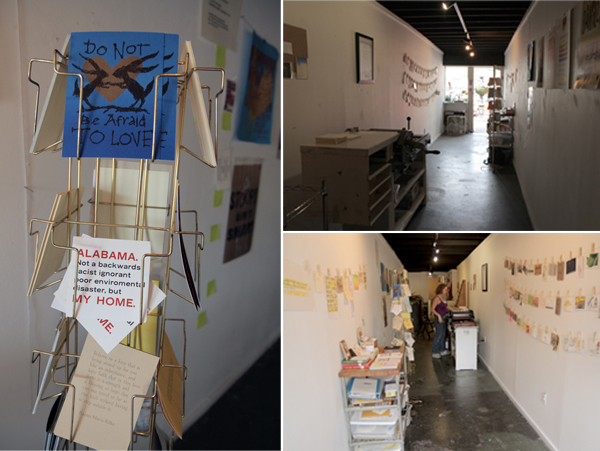
LOVE AT FIRST SIGHT I found my Vandercook SP-15 in 2009 in the basement of an old farmhouse in New Jersey, where it was sitting disassembled in about 10 different parts for the previous 20 years.
It was very dirty and rusty, and no one knew if it would even work. The only way to get it out of the basement was to lift each piece through a small 1 foot by 3 feet basement window. I had pieces shipped down to Gordo, Alabama where I was living. I spent a year and a half removing rust and cleaning the parts, and figuring out how to put the pieces back together. Through that process, I learned how Vandercooks work. I know my press very well.
SPREADING THE ART OF LETTERPRESS I am proudest of how I got my press and my work. I try to use my press and printing to serve my community in some way. The places where I live don’t have a great deal of access to art, graphic design, typography. Sometimes I miss living in a big liberal city like New York City, but I am proud of the work I do in Alabama and Mississippi to spread art and printing.
BOXCAR’S ROLE My Boxcar base! I like to print artists’ books on handmade paper, and photopolymer plates make that process feasible.
My last book, Ma’Cille’s Museum of Miscellanea, was 80 pages, and about 14,000 words. Without photopolymer plates to print the text with, I would still be typesetting today. Also, even though I’ve adopted the South, I will always have my upstate New York rust belt pride, and therefore I love supporting a company in Syracuse.

SHOP TIPS I think no matter what, you have to keep printing and keep finding things that you are interested in printing.
COMING SOON The Southern Letterpress will grow, and succeed. I am really excited. (I’m also excited about figuring out how to get around Alabama football merchandising licenses and copyright so that I can print a bunch of Crimson Tide items for the fall football session. Roll Tide!)
A huge rolling round of thanks out to Jessica of Paper Souvenir for letting us get a glimpse of her letterpress finesse!



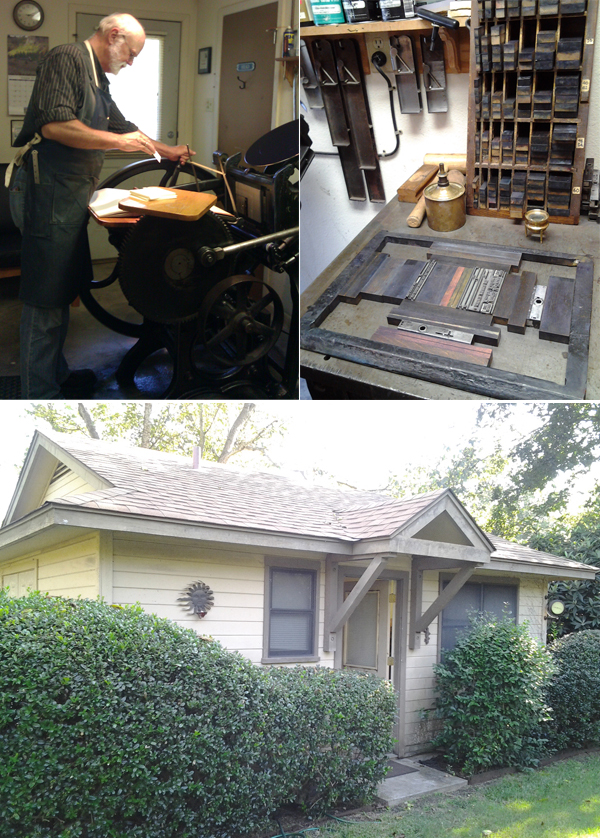























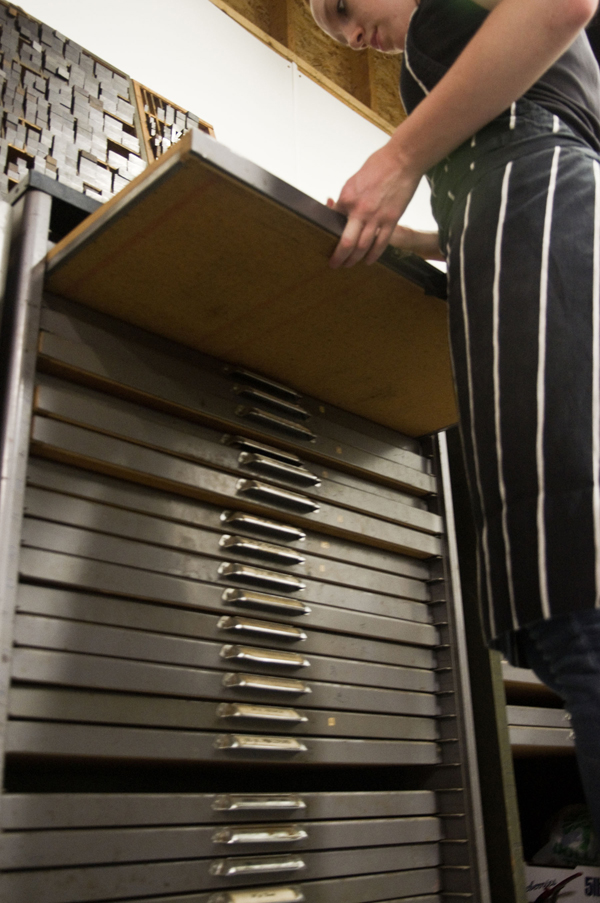
 I decided to get a Fuchs and Lang litho press tattooed on my back as a kind of homage to what is no longer made, and had plans to compliment it with an old style C&P 10X15 eventually; obviously not two at a time. These were by no means my first tattoos, and so I knew what I was getting into and knew what I wanted out of the artist. I found the appropriate engravings and took them to a few tattoo shops and talked to some folks/had consultations, and eventually settled on a fellow named Josh Egnew at 3 Kings who I had worked with before. Firstly, he did such a great job with the Fuchs and Lang that I was excited to bring him the drawing of this C&P; he kinda balked at it at first, as it was even more of a p.i.t.a. than the litho press, but after taking the time to trace it out for a transfer – he seemed happy enough, but a little bit reluctant. It took 2 sessions: one to outline and handle some of the shading, and the other to finish up the shading. By comparison, the litho press took him one session. I’m sure I squirmed a lot more for the C&P.
I decided to get a Fuchs and Lang litho press tattooed on my back as a kind of homage to what is no longer made, and had plans to compliment it with an old style C&P 10X15 eventually; obviously not two at a time. These were by no means my first tattoos, and so I knew what I was getting into and knew what I wanted out of the artist. I found the appropriate engravings and took them to a few tattoo shops and talked to some folks/had consultations, and eventually settled on a fellow named Josh Egnew at 3 Kings who I had worked with before. Firstly, he did such a great job with the Fuchs and Lang that I was excited to bring him the drawing of this C&P; he kinda balked at it at first, as it was even more of a p.i.t.a. than the litho press, but after taking the time to trace it out for a transfer – he seemed happy enough, but a little bit reluctant. It took 2 sessions: one to outline and handle some of the shading, and the other to finish up the shading. By comparison, the litho press took him one session. I’m sure I squirmed a lot more for the C&P.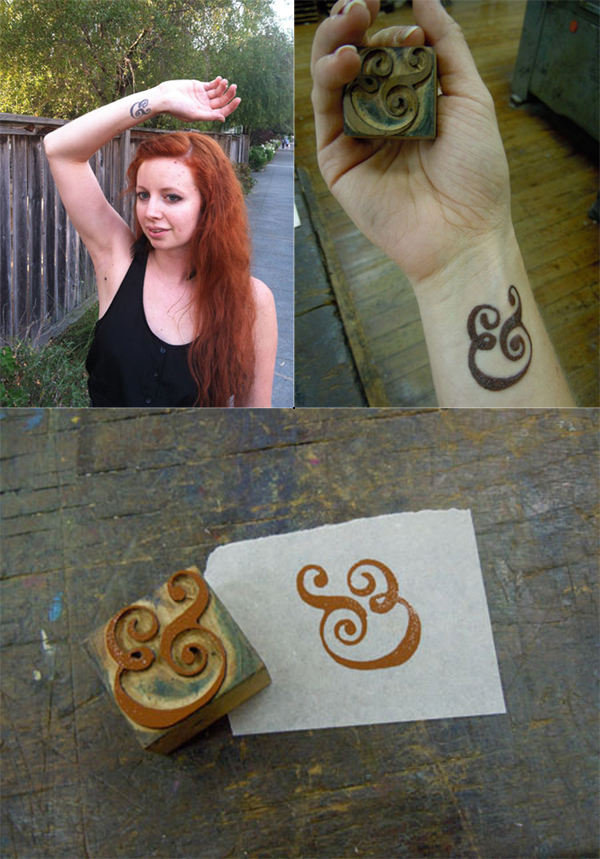 When I was about to graduate from CCA (California College of the Arts) with a degree in Graphic Design, I knew I wanted a bit more of a hands-on approach to design in my life than most of my classes had emphasized (I took a lot of letterpress and bookmaking on the side to make up for it). On a whim I applied to the Hatch Show Print internship program for the month after graduation, and I got accepted! Thus, my boyfriend and I relocated to Nashville, Tennessee for 6 weeks.
When I was about to graduate from CCA (California College of the Arts) with a degree in Graphic Design, I knew I wanted a bit more of a hands-on approach to design in my life than most of my classes had emphasized (I took a lot of letterpress and bookmaking on the side to make up for it). On a whim I applied to the Hatch Show Print internship program for the month after graduation, and I got accepted! Thus, my boyfriend and I relocated to Nashville, Tennessee for 6 weeks. While I was at the Ladies of Letterpress conference this year, I decided to get a type related tattoo as a souvenir. It’s a less obvious version of mind your p’s and q’s. When I look at it, it is a p and q within curly brackets and from the perspective of someone else, it is a b & d.
While I was at the Ladies of Letterpress conference this year, I decided to get a type related tattoo as a souvenir. It’s a less obvious version of mind your p’s and q’s. When I look at it, it is a p and q within curly brackets and from the perspective of someone else, it is a b & d. I had the tattoo done just a few months after dropping out of college here in Mexico City. My job back then required me to do a whole lot of print work for the company I used to work. However, being so inexperienced and contact-less after dropping out, I had to try quite a lot of print shops, most of which produced less-than-stellar results.
I had the tattoo done just a few months after dropping out of college here in Mexico City. My job back then required me to do a whole lot of print work for the company I used to work. However, being so inexperienced and contact-less after dropping out, I had to try quite a lot of print shops, most of which produced less-than-stellar results.
